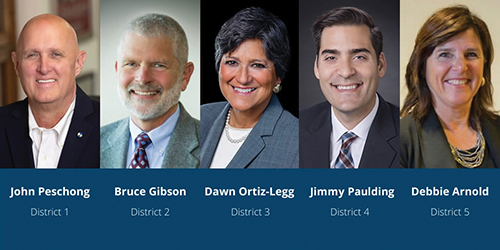The current County Board of Supervisors is from left: Dist. 1’s John Peschong; Dist. 2’s Bruce Gibson; Dist. 3’s Dawn Ortiz-Legg; Dist. 4’s Jimmy Paulding; and, Dist. 5’s Debbie Arnold. The board voted 3-2 with Peschong and Arnold dissenting, to ask the State Legislature to allow them to form an Independent Redistricting Commission ahead of the 2030 Census and the next time Supervisorial Districts are up for possible changes.
A 3-2 split County Board of Supervisors have lent their support to a bill that would allow them to form a citizen’s redistricting commission and avoid the kind of election shenanigans that happened the last time Supervisors were charged with redrawing their districts.
County Counsel, Rita Neal’s report said our State Sen. John Laird had introduced Senate Bill 977, which if passed would allow SLO County to form an Independent Redistricting Commission.
Forming such commissions can be done two ways, according to Neal. One is to put an ordinance to the voters to decide or to seek State Legislation authorizing it. Last January, a split Board directed the staff to work with Sen. Laird on the legislative solution.
“Staff was directed to work with Senator Laird’s office,” Neal said, “to draft legislation with certain preferred components. Those components included creating a commission consisting of 11 members, requiring at least five public meetings prior to the drafting of a new map and requiring at least three public meetings after a map is drawn. Staff was directed to return to the Board with an update on the process.”
Like anything else, the road ahead was full of baby steps. “Conversations ensued with Senator Laird’s office,” Neal reported, “with an eye to drafting legislation that was similar to the legislation existing for seven other counties but was also tailored to address the preferences of the Board and the public. Staff prepared an initial draft of the legislation and submitted it to Senator Laird’s office.
“Conversations also began with staff from the Legislative Counsel’s office, the Committee on Senate Rules and the Senate Committee on Elections and Constitutional Amendments for purposes of finalizing language, getting clarity on timing to get the proposed legislation to the appropriate committees, and determining when the County would need to provide testimony in support of the bill.”
What emerged was SB 977, which calls for: an 11-member districting commission, with two people from each of five Supervisorial Districts, plus one person chosen at large.
Political party preferences “shall be as proportional as possible to the total number of voters who are registered with each political party or who decline to state or do not indicate a party preference.”
Members must be SLO County residents (living in their respective districts), and a registered voter; and must have voted in at least one of the past three statewide elections.
Also, members must, “Have not changed registered political party affiliation or had no political party affiliation within the past five years immediately preceding the date of their appointment to the commission.”
Members must also be eligible to serve according to State Law (California Elections Code Sec. 23003), governing qualifications of commissioners for independent redistricting commissions. The law lists:
• Cannot be appointed by the legislative body.
• In the eight years preceding a person’s application, the person or person’s spouse: May not have served an elected or appointed position in the local jurisdiction.
• May not have served as an officer of, employee of, or paid consultant to a campaign committee, candidate for elective office, political party or elected or appointed member of a political central committee in the local jurisdiction.
• May not have served as a staff member or consultant to, or who has contracted with, or currently serving elected officer of the local jurisdiction.
• Been a registered lobbyist to a local jurisdiction.
• Contributed $500 or more in a year to any candidate for an elective office of the local jurisdiction.
These same requirements also apply to a candidate’s family members — parent, sibling, child or in-law — but only would go back four years, instead of eight.
And not just anyone would do. According to Neal’s report, each applicant must:
• Possess experience that demonstrates analytical skills relevant to the redistricting process and voting rights and possess an ability to comprehend and apply the applicable state and federal legal requirements.
• Possess experience that demonstrates the ability to be impartial.
• Possess experience that demonstrates an appreciation for the diverse demographics and geography of the County of San Luis Obispo.
SB 977 must still navigate the State Legislature and various committees in both the Assembly and Senate, and once approved by both bodies, it would go to the Governor for his signature. Neal predicted that might happen sometime in August. Should Gov. Newsom sign it, it would go into effect Jan. 1, 2025. But there won’t be any need to worry about it now, as Supervisorial Districts only come up for changes after each U.S. Census, with the next one due in 2030.
The redistricting commission was the Board majority’s way to avoid the kind of shenanigans that occurred over the past two election cycles.
In 2021, the Board majority adopted a new district map that was very different from the one in effect since the 1980s.
That map took Morro Bay and Los Osos plus a sizable chunk of San Luis Obispo out of Dist. 2.
Morro Bay and roughly half of SLO were combined into a new Dist. 3 and Los Osos was put into Dist. 5. Dist. 2 added Atascadero, about half of Templeton and San Miguel (plus Cayucos and Cambria). Dist. 5 included the sparsely populated eastern portion of the county and the extreme southern end of the County and Nipomo.
The change meant SLO, Los Osos and Morro Bay were denied a chance to vote for County Supervisor in the 2022 elections.
Dawn Ortiz-Legg, who was appointed to the Dist. 3 seat in 2020, after the death of former Supervisor Adam Hill, had to face voters to keep her seat.
But under the Election Codes, the voters from the old Dist. 3 (Pismo and Grover Beach, Avila and part of SLO) got to vote again. She won a 2-year term (to finish out Hill’s 2020 term) and had to face voters once again in 2024.
The new 2021 map was used in the 2022 Elections when Dist. 2’s Bruce Gibson and Dist. 4’s Lynn Compton were up for re-election. Gibson and Compton’s challenger, Jimmy Paulding won that election. That coupled with Ortiz-Legg’s win, flipped the majority over to liberal from conservative. The new board threw out the 2021 map and in 2023, approved a map that basically returned to the same districts as before.
That moved SLO, Los Osos and Morro Bay back into Dist. 2, however, it also took away their ability to vote in the Dist. 3 2024 Supervisorial Election, and the second straight election they missed.
The biggest benefactor in this mess was Ortiz-Legg, who got to stay in Dist. 3 and ran unopposed in the March 2024 Primary Election, taking the win in a near walkover and getting a full, 4-year term. (There was a weak, write-in candidate who also ran, but garnered less and 1,000 votes.)
The independent commission will be chosen from a field of up applicants who will first be vetted by the County Elections Office to make sure they qualify. Sixty names will come out of this initial vetting.
The County Clerk would then divide the applicants by District, and select one name from each district to seed the panel, figuratively, pulling a name out of a hat.
The chosen members would then select a second member from the list of qualified applicants in each District. The at-large member would be chosen from the remaining qualified applicants and can be from any of the five districts.
This method would seem to remove it from the highly partisan politics that muffed up the previous two election cycles and twice denied about 30,000 voters a chance to pick their County Supervisor.
It should be noted that County Supervisor seats here are non-partisan positions, meaning that their party affiliations cannot be used in official election literature — the Sample Ballots, Candidate Statements — and do not appear with a candidate’s name on the actual ballot.
This redistricting commission won’t be cheap. “The County,” Neal said, “will incur anticipated costs to support a citizens’ redistricting commission. Costs include consulting costs for administration, outreach, demographic analysis, translation services, mapping tools and map preparation, audio/visual support, and legal counsel to support the independent commission.
“Additionally, County staff costs from Elections, County Counsel, and the County Administrative Office will be incurred.”
She estimated the costs to run between $750,000 to $1 million “for the 2030 redistricting process.”




